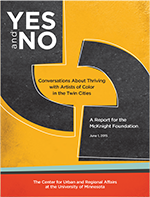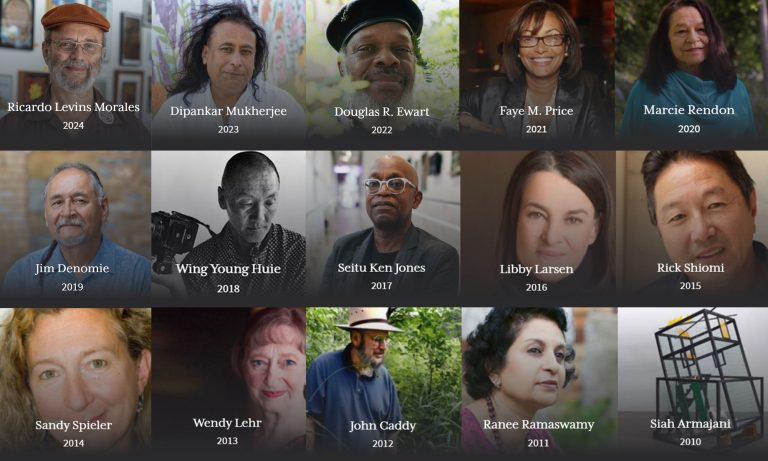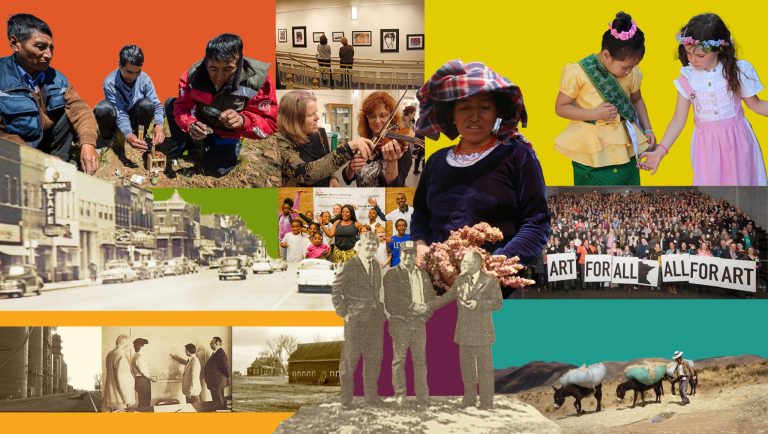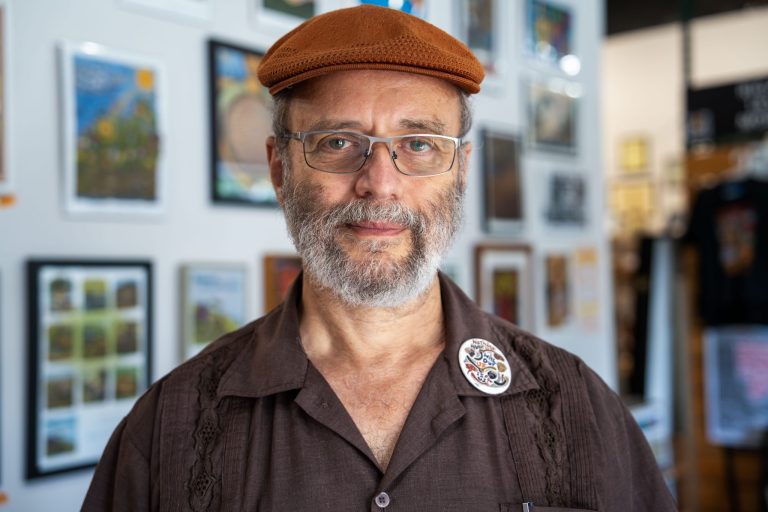I came to philanthropy after nearly a decade as the executive director of a culturally-specific arts organization. I understand that in addition to the general struggle to thrive that exists for most artists and arts organizations, artists of color and arts organizations founded and led by people of color especially struggle to own space in which to produce and perform their works; struggle to control the direction or production of their work; struggle to advance positive images and alternative aesthetics derived from their cultures; struggle to get beyond discussions of diversity and inclusion to attend to the deep work of nurturing and advancing their aesthetics; struggle to have the resources to build out, preserve, access, and distribute alternative artistic cannons; struggle to explore and fully represent complex artistic identities; struggle to be valued for their work in building community within a context that privileges and promotes individualism; struggle to garner sufficient community support beyond short-term events and annual programs to get long-term support for sustained general operations. My list could continue.
I know that these artists and arts organizations are not struggling because they are incapable. They are struggling because resources and opportunities are structurally and systematically denied to them. More often than not, artists of color and arts organizations established and led by people of color don’t get the resources they need to survive, let alone to thrive.
Research Shows Major Disparities in Arts Funding
The research is worth revisiting. In 2011, the National Committee for Responsive Philanthropy published Fusing Arts, Culture and Social Change. In the report, researcher Holly Sidford found 55% of arts funding (contributions, gifts, and grants) supports large organizations with budgets greater than $5 million. That means less than 2% of the universe of arts and culture nonprofits receive more than half of the sector’s total revenue. As the DeVos Institute reported in its 2015 study of Diversity in the Arts, “…the 20 largest mainstream organizations have a median budget of $61 million; the 20 largest organizations of color have a median budget size of $3.8 million.” A difference of 16 times in median budget size is a glaring illustration of disparity.
If we do not address the bigger questions of how and why such disparities exist, they will continue. If we do not address race, the reality of racism, and its role in creating disparities, they will continue. Given historic inequities and shifting demographics, increasing arts funding alone does not address the structural issues affecting how these funds are distributed. We must change the minds (leadership and decision making) and the mechanisms (the institutional policies and practices) that prevent more equitable distributions of resources. This is racial equity work.
Philanthropy is social change work. The opportunity to participate as an agent of change attracted me to this field. From here I see two paths, both are necessary: 1) transform existing systems to be more equitable and 2) establish and grow new alternatives for resource distribution.
Arts Funders Coming Together to Address Racism
I am glad that we don’t have to start from scratch. I am especially thankful for the leadership of Grantmakers in the Arts (GIA), the national service organization for arts funders led by a diverse and progressive board. I appreciate the explicit commitment this organization is making to advance racial equity as articulated in its Racial Equity in Arts Philanthropy Statement of Purpose. As a new board member, I was required to attend an intensive training on structural racism that turned out to be the most cohesive analysis of racism in the United States and presentation of anti-racism organizing strategies that I’ve ever been a part of. This year, GIA is conducting a full racial equity review of its organizational practices and programs with the goal of increasing its ability to support member organizations in similar work.
Here in Minnesota, I am also glad that I don’t have to walk alone. For nearly three years, arts funders from The McKnight Foundation, Jerome Foundation, Bush Foundation, Minnesota Philanthropy Partners, the Minnesota State Arts Board, and the Nonprofits Assistance Fund have created the Racial Equity Funders Collaborative to develop synergistic strategies for advancing racial equity in philanthropy as informed by artists and arts and culture organizations in our communities. The group has evolved as a learning community, and over the past two years has participated in conversations and trainings, hosted events for grantmakers, initiated exploratory conversations with artists and art organizations that are working to transform existing systems and to develop alternatives, and collaborated to provide support for new equity-related initiatives in the arts.
A Learning Agenda for McKnight’s Arts Program
At The McKnight Foundation, I appreciate that we include references to race and culture in our 2015-2017 Strategic Framework. The organization has voiced a commitment to: “Work collaboratively across communities and sectors to eliminate deep and persistent cultural, economic, and racial barriers to shared well-being. The civic and economic vitality of our home state of Minnesota depends on inclusive and equitable opportunities for everyone.”
 McKnight’s Arts program is currently developing a learning agenda around racial equity that includes a critical analysis of our own grantmaking as well as a deepening understanding of the structural determinants that contribute to disparities in support for artists of color and arts organizations founded and led by people of color. Last year, the McKnight Arts program commissioned the University of Minnesota’s Center for Urban and Regional Affairs (CURA) to conduct a series of conversations with 25 artists of color in the Twin Cities. The report, entitled Yes and No: Conversations About Thriving with Artists of Color in the Twin Cities, documents the learnings and recommendations from these talks. These conversations made clear that the work of many of these artists flowed from their lived experiences and that their artistic practices are often pursued as acts of agency and praxes of liberation intended to catalyze an elevation in social consciousness and the regeneration of community. For several years, McKnight’s Arts and Region & Communities programs have funded CURA’s Artist Neighborhood Partnership Initiative, making grants to individual artists working in communities of color and low-income communities who want to create projects contributing to community building, development and revitalization with an emphasis on increasing equity.
McKnight’s Arts program is currently developing a learning agenda around racial equity that includes a critical analysis of our own grantmaking as well as a deepening understanding of the structural determinants that contribute to disparities in support for artists of color and arts organizations founded and led by people of color. Last year, the McKnight Arts program commissioned the University of Minnesota’s Center for Urban and Regional Affairs (CURA) to conduct a series of conversations with 25 artists of color in the Twin Cities. The report, entitled Yes and No: Conversations About Thriving with Artists of Color in the Twin Cities, documents the learnings and recommendations from these talks. These conversations made clear that the work of many of these artists flowed from their lived experiences and that their artistic practices are often pursued as acts of agency and praxes of liberation intended to catalyze an elevation in social consciousness and the regeneration of community. For several years, McKnight’s Arts and Region & Communities programs have funded CURA’s Artist Neighborhood Partnership Initiative, making grants to individual artists working in communities of color and low-income communities who want to create projects contributing to community building, development and revitalization with an emphasis on increasing equity.
Celebrating Community Initiative
As we move forward with this work, I think it is important that we also celebrate successes. Recently, the Saint Paul Almanac and Ananya Dance Theater celebrated 10-year anniversaries. Penumbra Theatre is celebrating its 40th season. Mu Performing Arts and Teatro del Pueblo will celebrate their 25th year anniversaries in 2017. I find encouragement in the growth and award-winning work of Juxtaposition Arts and the positive potential of new leadership at the Guthrie and Intermedia Arts. The McKnight Foundation has been a long-standing and proud funder of these organizations.
I am also inspired by the artists and arts organizations who are not waiting for permission to strategically organize, to create forums, to network, and to create, find, and share resources. The Twin Cities Theaters of Color Coalition comes to mind. I’m paying attention to the new models of community engagement and giving happening at the Headwaters Foundation. Nationally, I’m enthusiastic about the great work that is happening to develop more leaders from diverse communities, to increase traditional support, to develop alternative means of support, and to advance networks. The Intercultural Leadership Institute, a partnership between the National Association of Latino Arts and Cultures, Alternate Roots, and First Peoples Fund, is doing great work. ArtChangeUS is calling out the demographic shifts happening in our country and working to develop intentional networks as well as collaborative opportunities between artists, activists, scholars, and cultural changemakers. There’s a lot of good work going on.
Artists Taking Action, Shining a Spotlight on Disparities
In my work in arts philanthropy, I am on a mission to improve the quality of life for all Minnesotans. When it comes to structural inequities and the systems that preserve and perpetuate those inequities within the arts and beyond, philanthropy is a work in progress. Racial equity work presents us with an opportunity to live more deeply into our values and to equip ourselves for the tough and necessary work of advancing socially equitable and sustainable communities. We need to do more to listen, learn from, and support the work of our community partners. Within and beyond the arts, artists of color are actively working to shine a spotlight on the disparities impacting their communities. Exercising creativity and imagination to provoke more complex understandings of our humanity in its richness and its flaws, many of these artists are also taking action to confront oppressive and dehumanizing aspects of the status quo. These artists are not just holding a mirror up to our society. They are working to reshape our society by provoking the creative and regenerative opportunities of democracy and by challenging us to follow through on our commitments to “quality of life” and “liberty and justice” for all.


